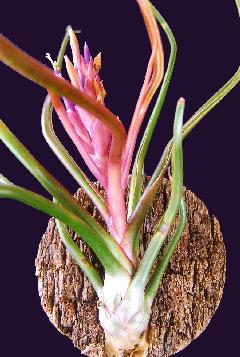

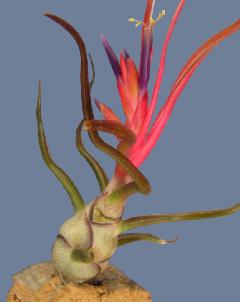
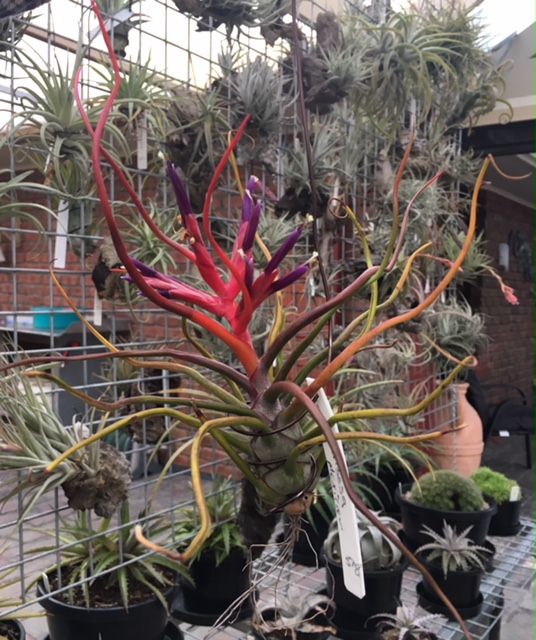
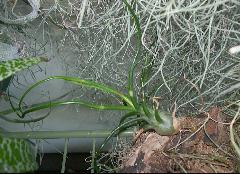
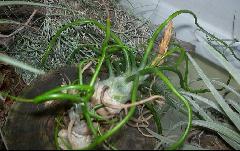
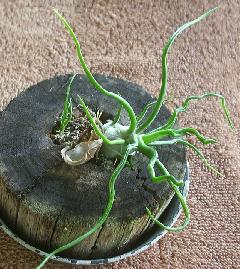
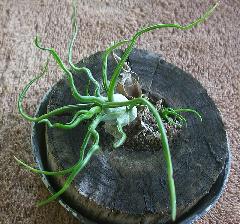
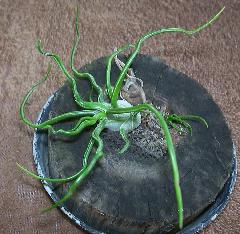
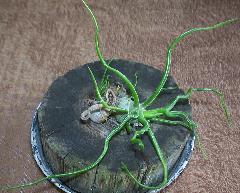
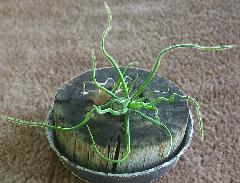

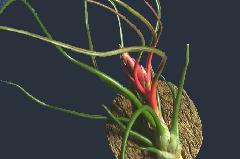
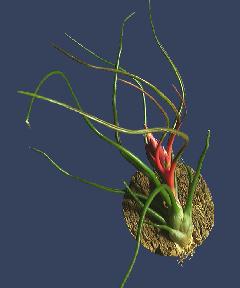

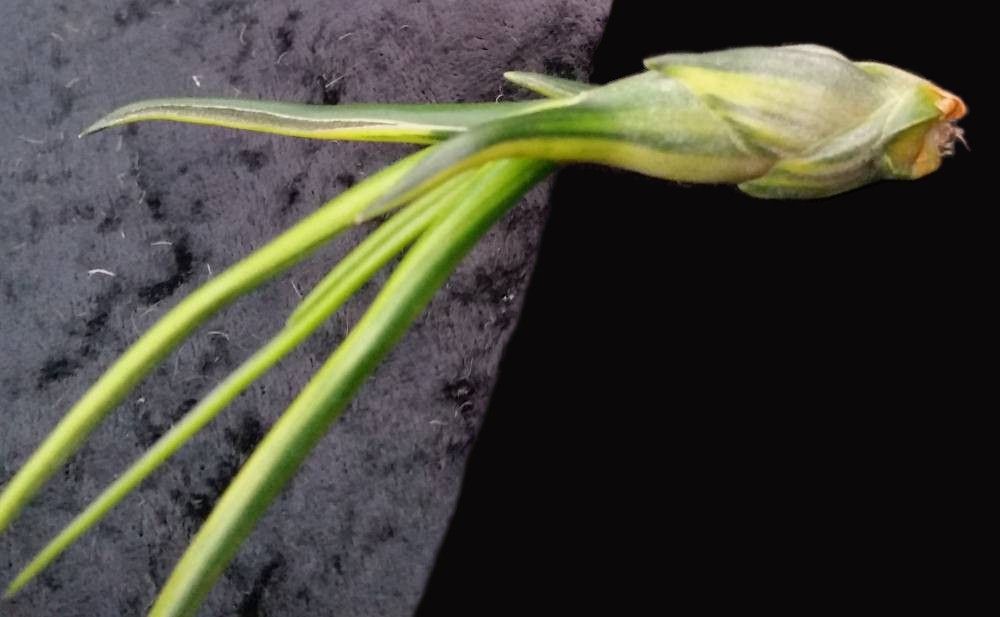
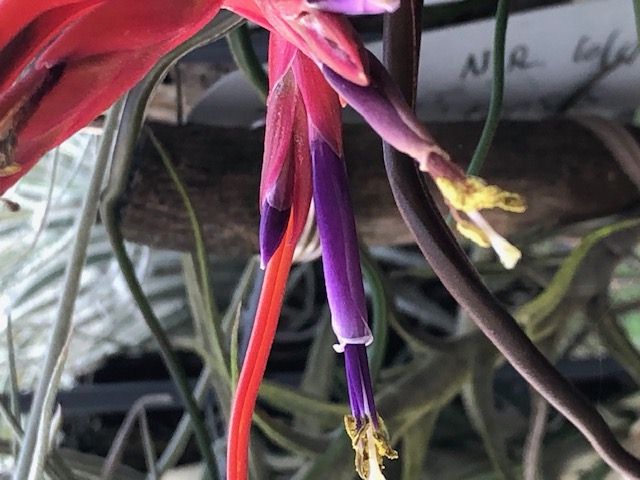

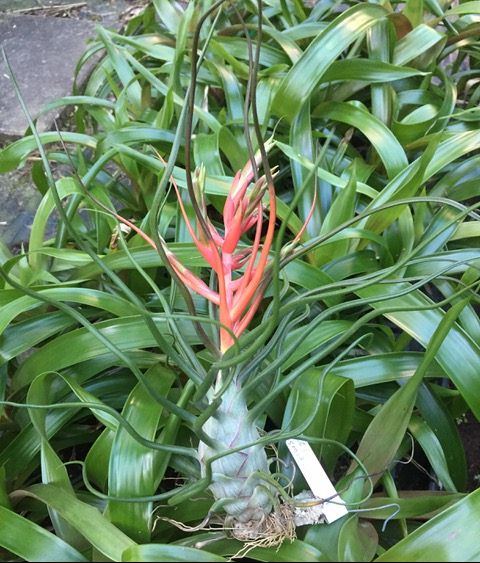
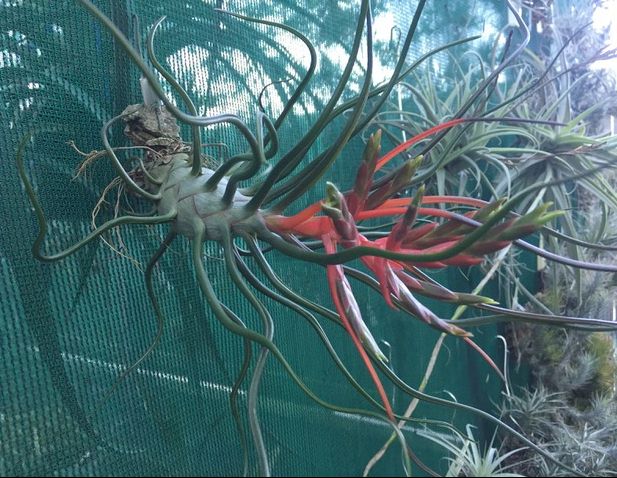
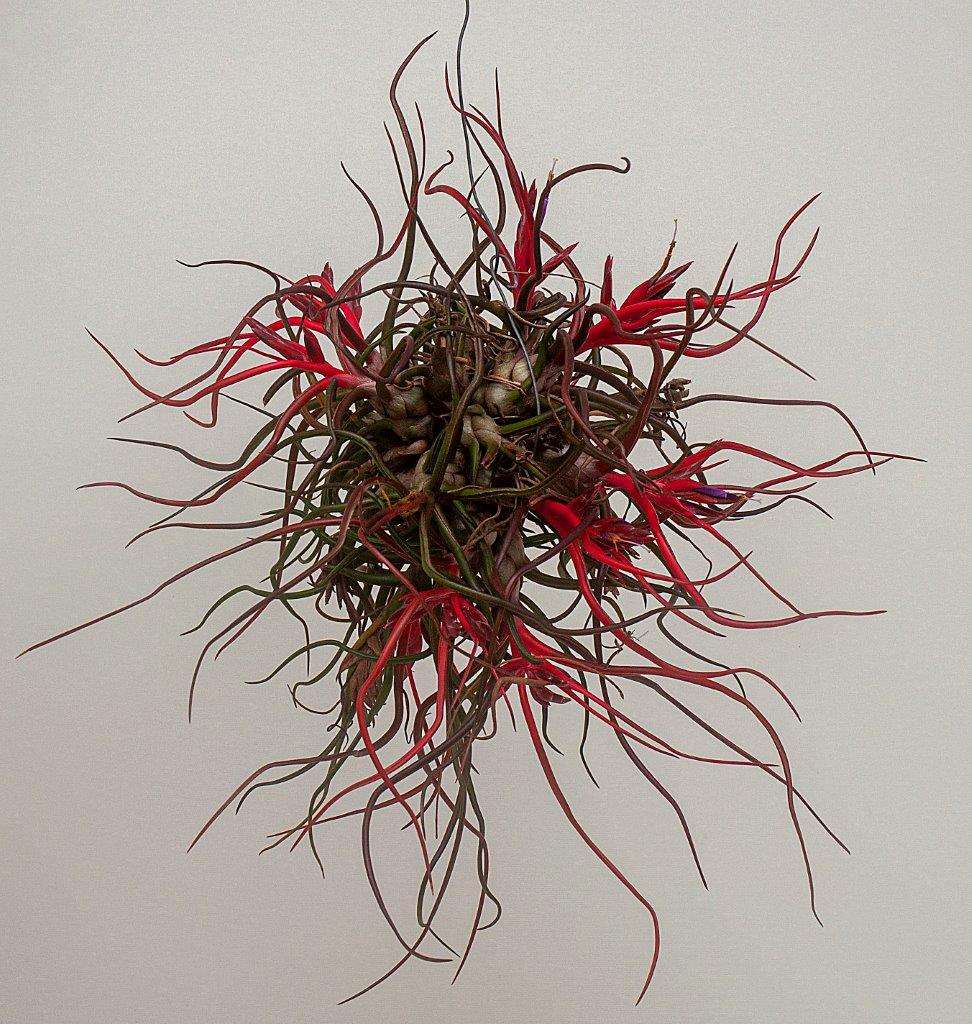
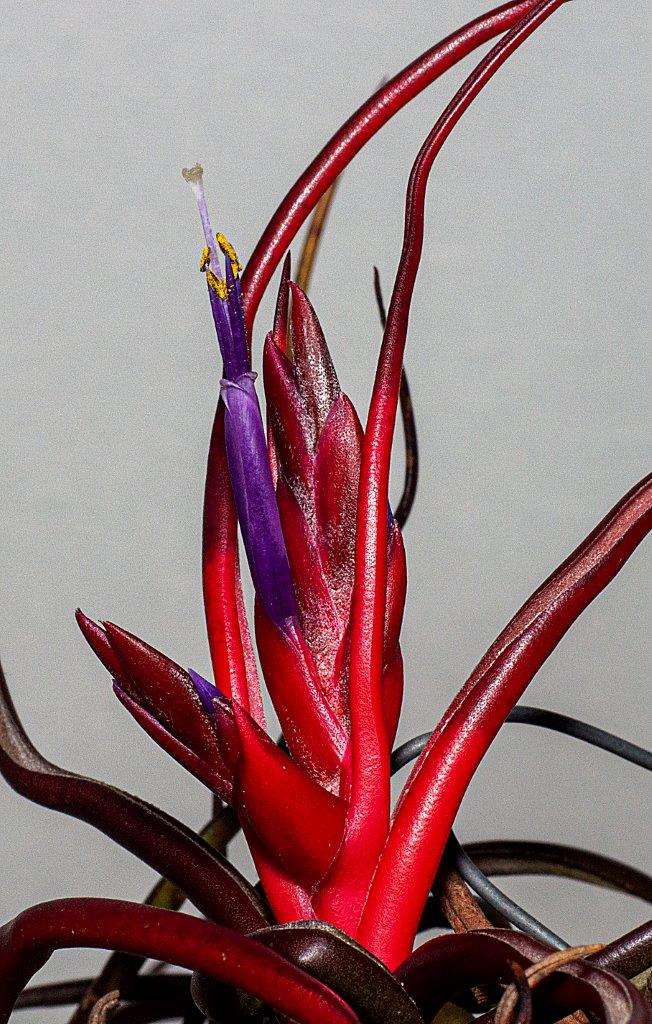

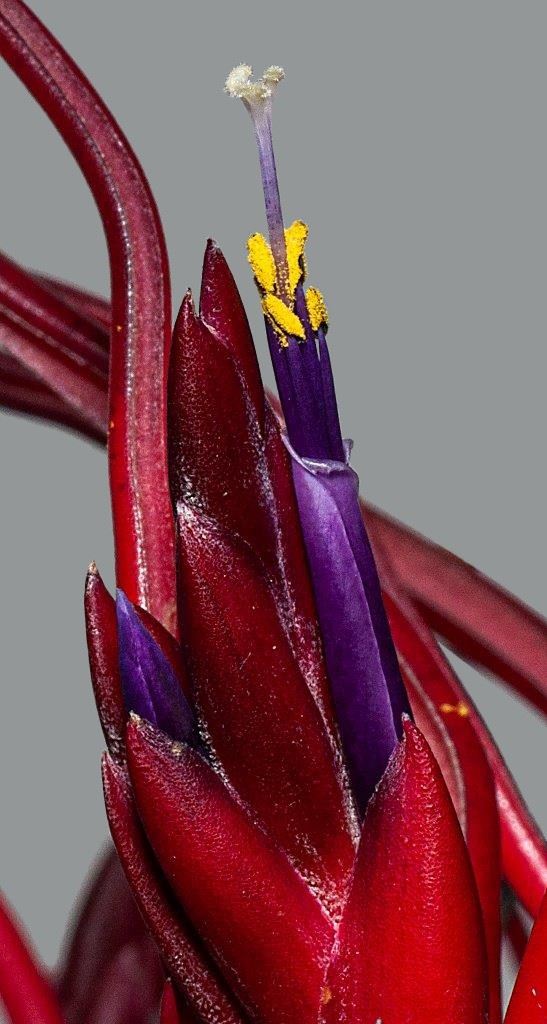
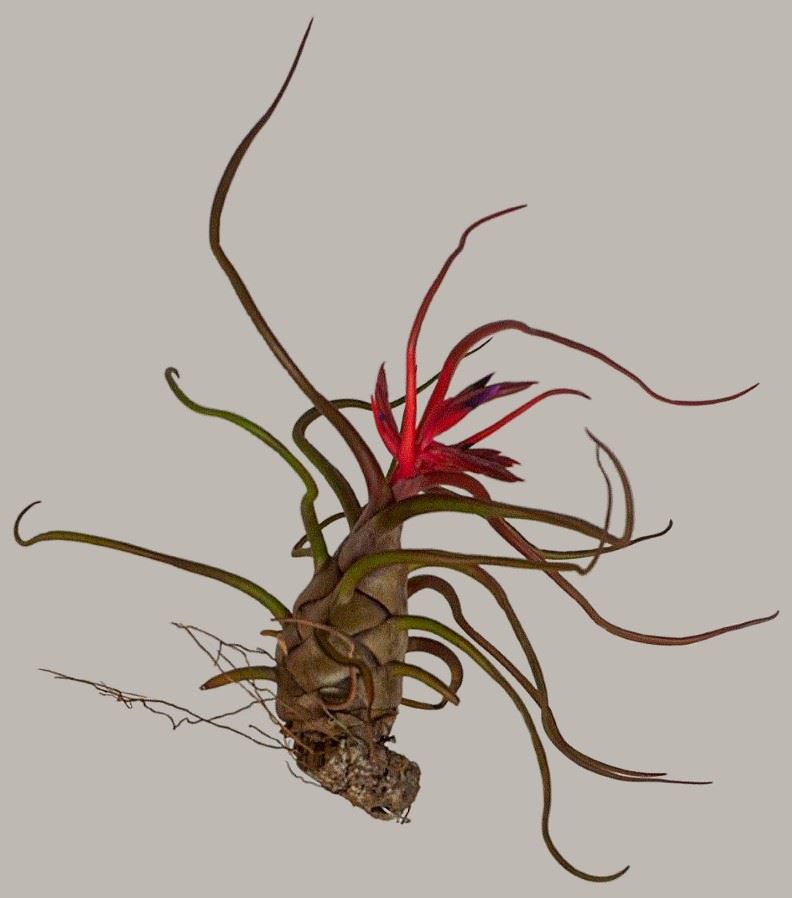
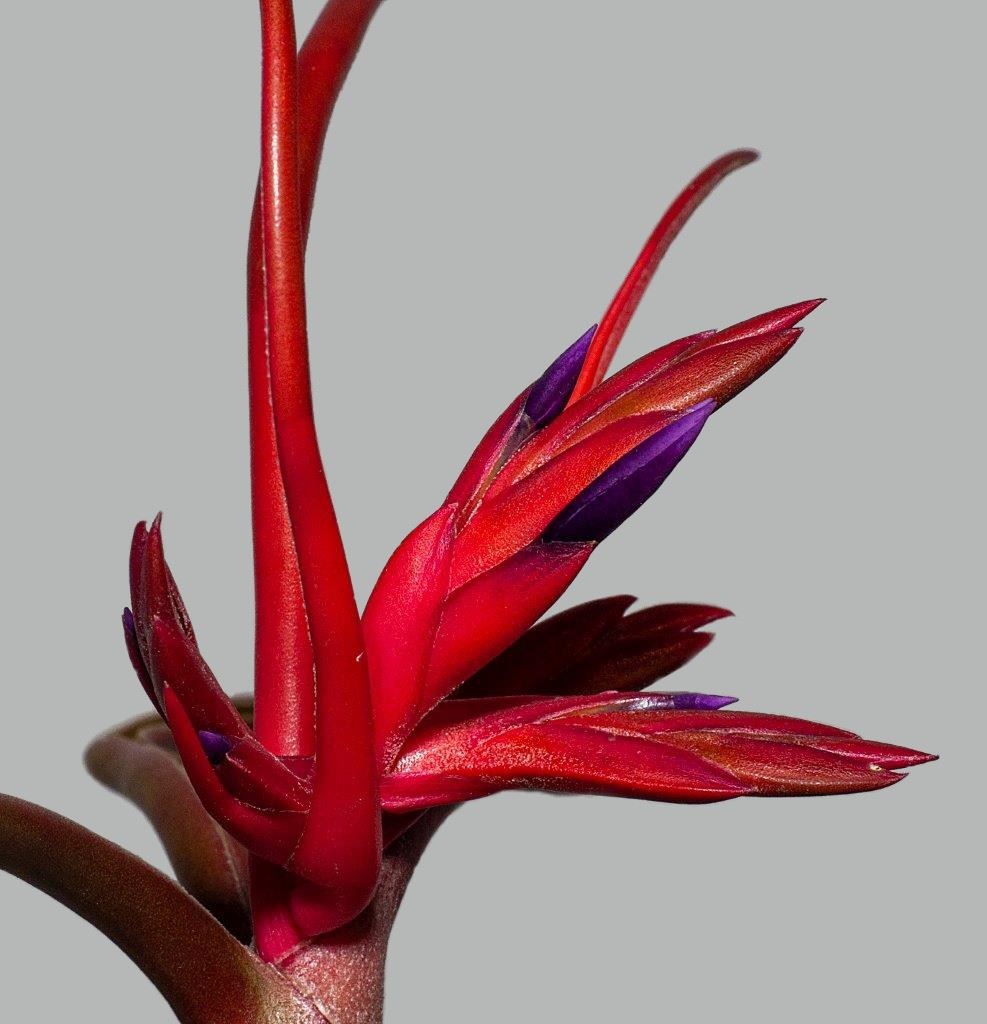
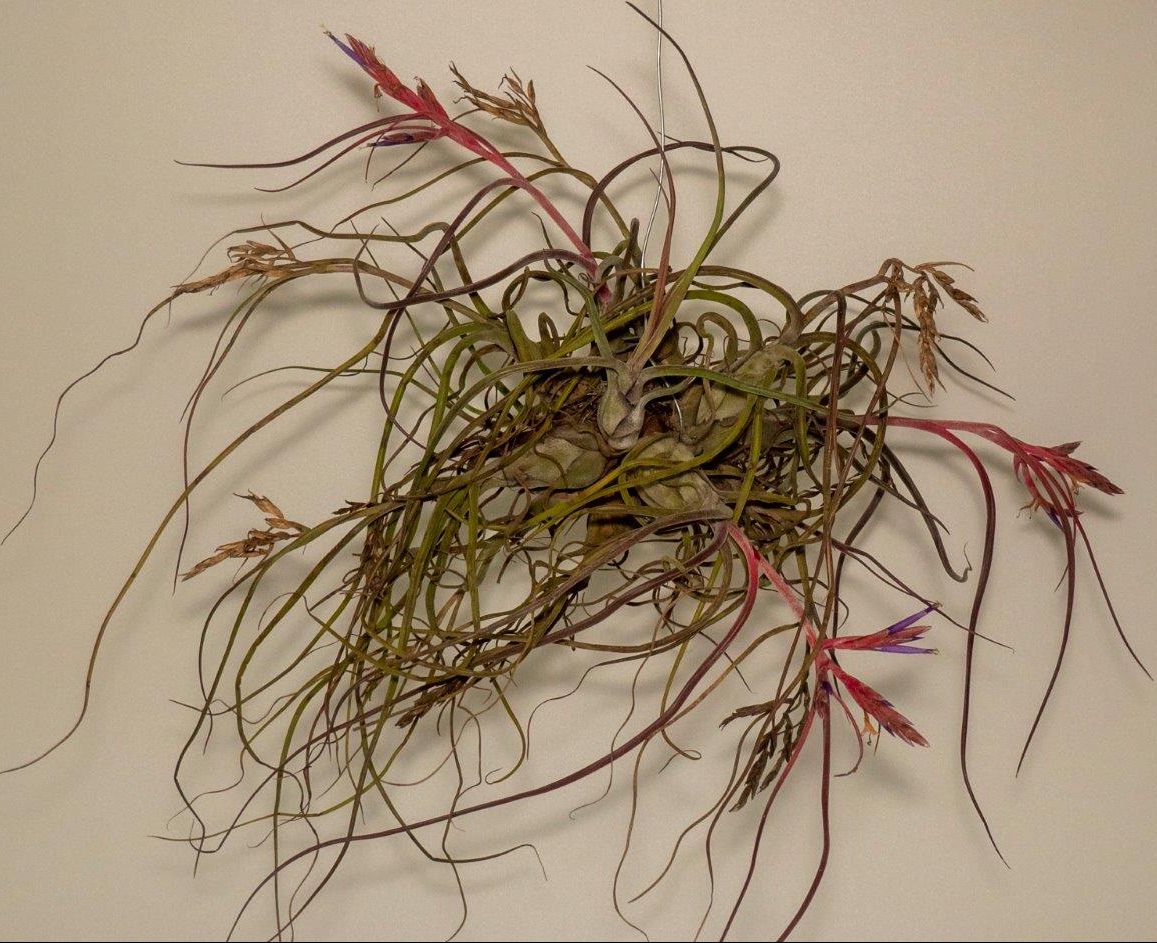
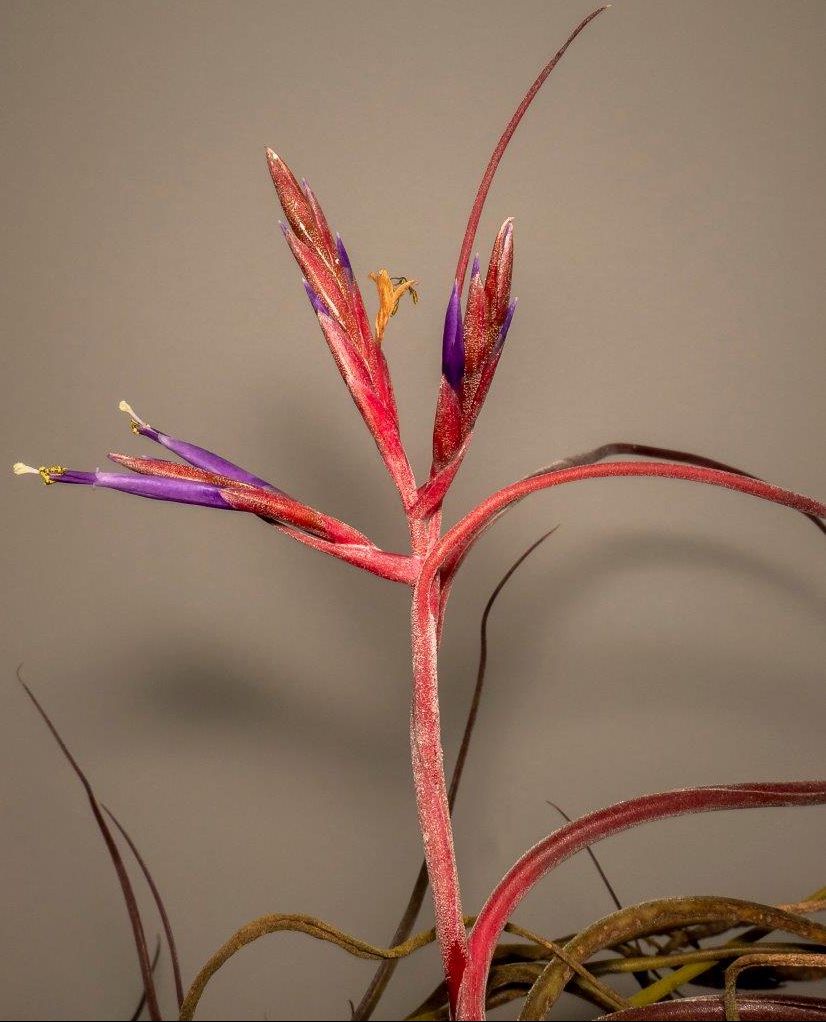

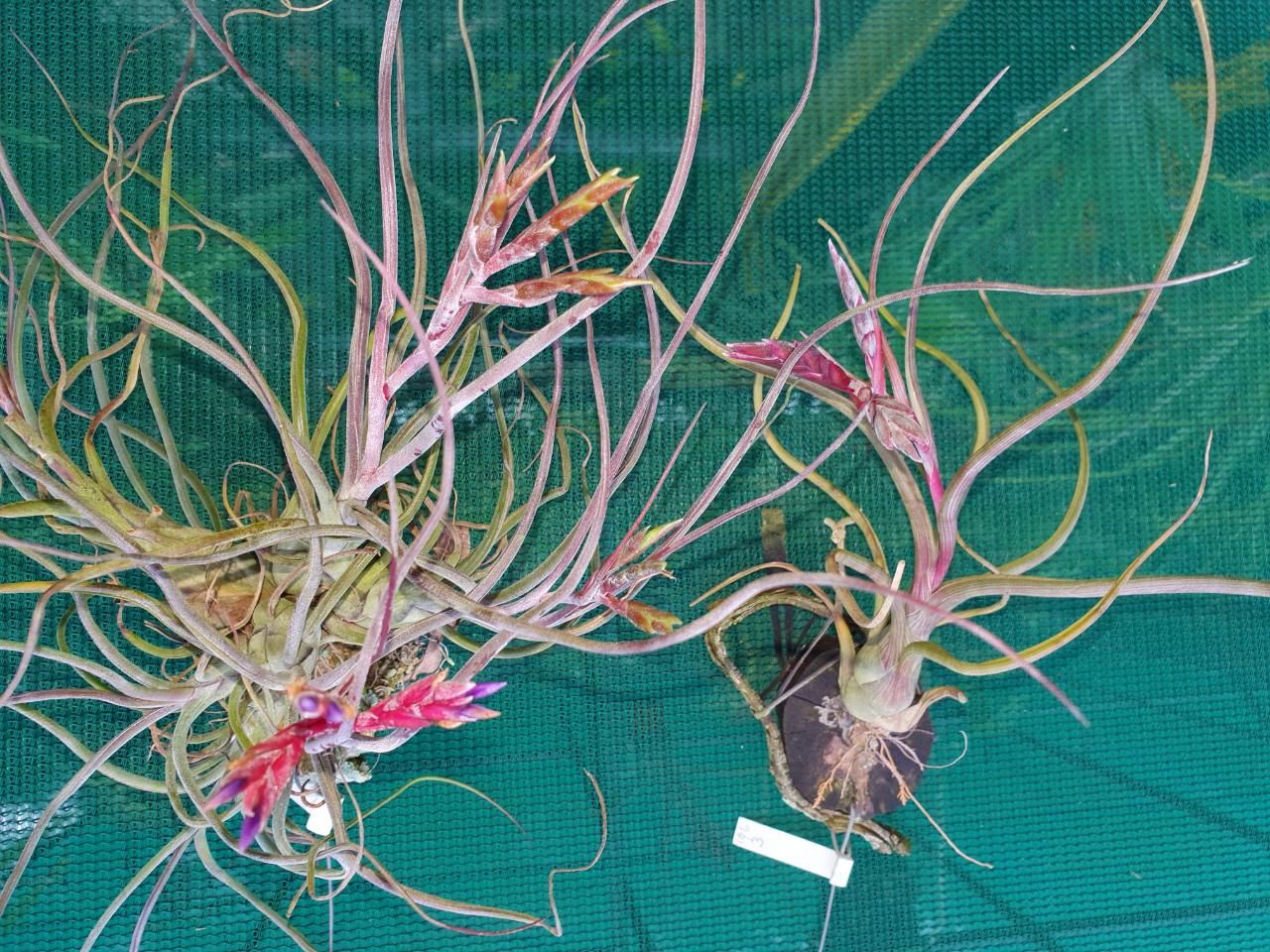
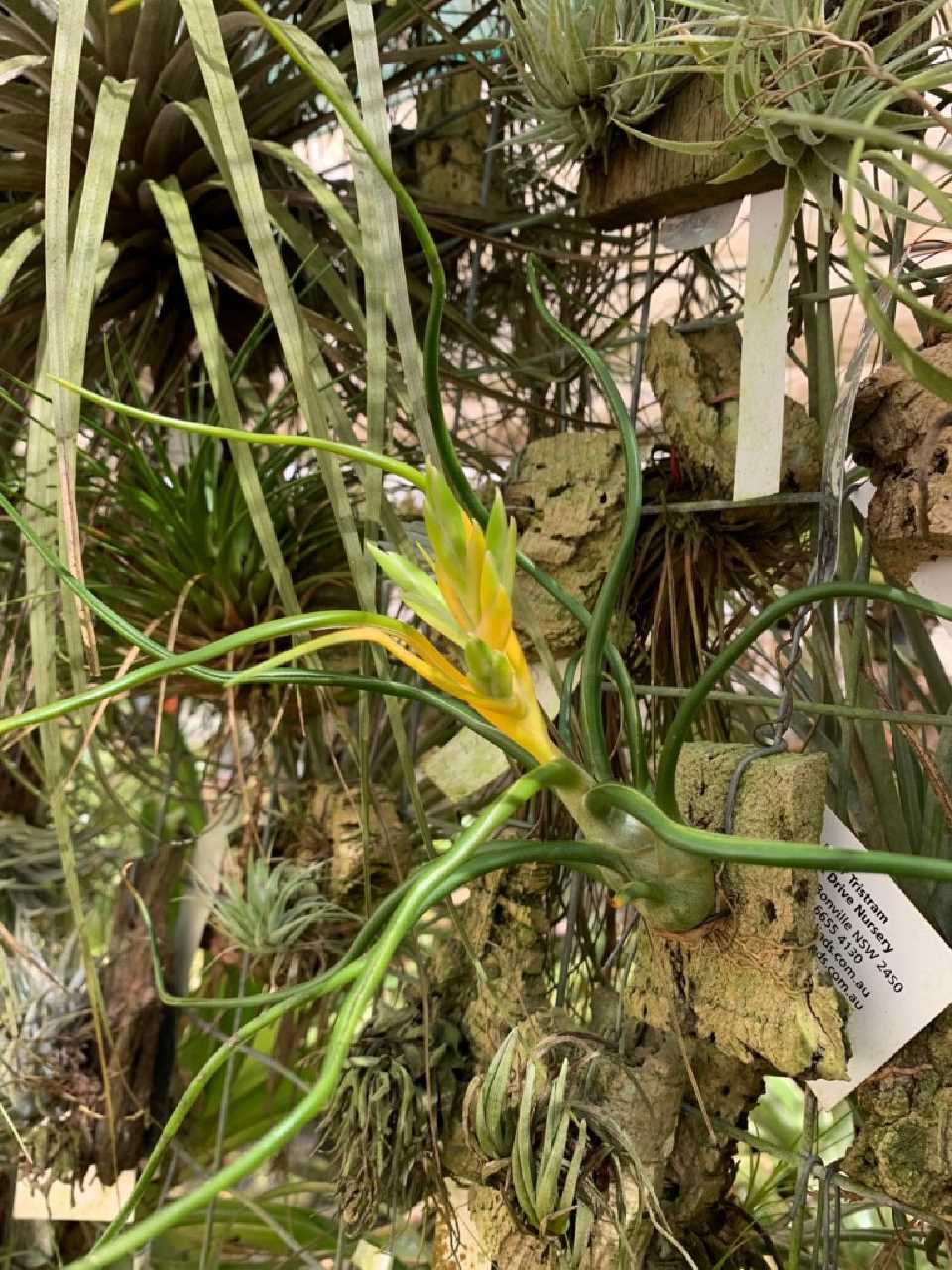
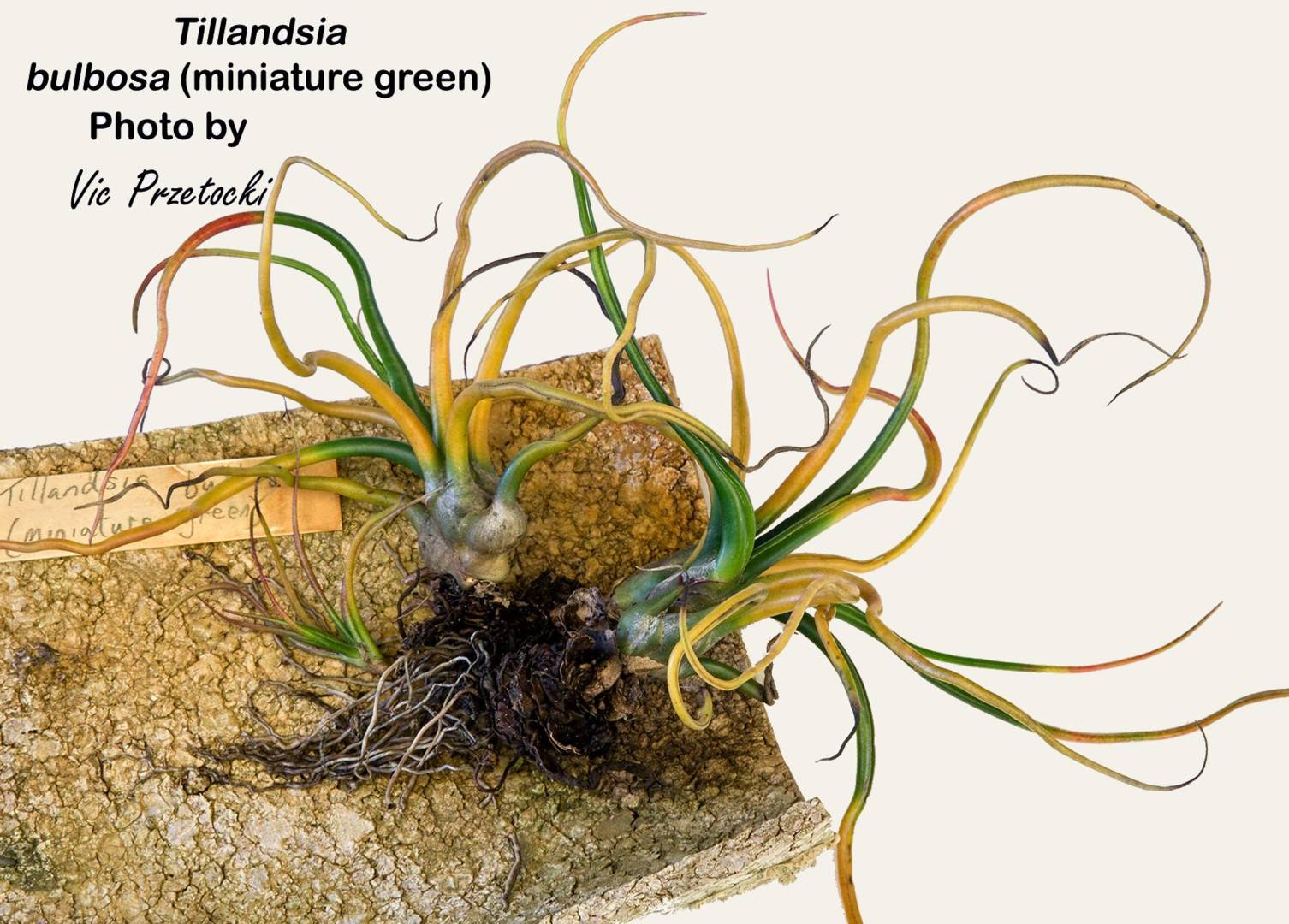

TiIIandsia buIbosa .ß brasiliensis Schultes filius in Roemer & Schultes, Syst. 7(2): 1212. 1830. Type. Rio Japura, Amazonas, Brazil, Martius s n (! Mez, n v).
Tillandsia buIbosa var picta Hooker Bot. Mag. 73: pI. 4288. 1847. Type. Purdie in Kew Hortus s n (K), Jamaica.
Pourretia hanisiana Morren ex E. Morren, Ann. Cand 3: 255. 1847; nomen.
Tillandsia inanis Lindley & Paxton, Paxton's Fl. Card. I: 159. 1850. Type: SuIivan in Lemon Hortus s n. No material known, typified by description. now synonym of T. butzii
Tillandsia erythraea Lindley & Paxton, Paxton's Fl. Card. I: 160. 1850. Based on Tillandsia buIbosa var picta Hooker.
Tillandsia pumiIa Lindley & Paxton, Paxton's Fl. Card. I: 160. 1850. Type. No material cited, typified by description.
Platystachys inanis (Lindley & Paxton) Beer, Bromel. 82. 1857.now synonym of T. butzii
PIatystachys buIbosa (Hooker) Beer, Bromel. 83. 1857.
Platystachys erythraea (Lindley & Paxton) Beer, Bromel. 83. 1857.
Tillandsia pumila Grisebach, Nachr. Ges. Wiss. Gott. "1864": 16. 1865; non Lindley, 1850. Type. Maracai to Choroni, Carabobo, Venezuela, Fendler 2163 (GOET).
Plant stemless, usually densely aggregated, 7-22 cm high, very variable in size and color.
Leaves 8-15, often exceeding the inflorescence, covered with fine, closely appressed, cinereous scales;
Sheaths orbicular, abruptly contracted into the blades, greatly inflated, 2-5 cm long, forming a dense ovoid pseudobulb (long-fusiform in some non-persistent sports), green or greenish-white, often with a narrow red or purple marginal band;
Blades involute-subulate, attenuate, contorted, spreading and at least the outer ones making a sharp angle with the apex of the sheath, to 3 dm long, 2-7 mm in diameter
Scape erect;
Scape-bracts foliaceous in form with elongate blades exceeding the inflorescence, the upper ones often red.
Inflorescence simple or subdigitate from a few spikes, red or green;
Primary bracts ovate, acute, much shorter than the axillary spikes but their foliaceous blades sometimes exceeding them;
Spikes spreading, lanceolate, acute, complanate, 2-5 cm long, 2-8-flowered;
Rhachis slender, lepidote.
Floral bracts erect, imbricate, ovate, acute, 15 mm long, exceeding the sepals, two to three times as long as the internodes, subchartaceous, densely and finely appressed-lepidote, carinate;
Flowers sessile.
Sepals oblong, apiculate, 13 mm long, glabrous, more or less connate, posteriorly;
Petals linear, acute, 3-4 cm long, blue or violet;
Stamens and pistil exserted.
Capsule cylindric, to 4 cm long.
Type. De Schach s n. No material preserved, typified by original description and plate. DISTRIBUTION. Epiphytic, from near sea level to 1350 m alt, Mexico and the West Indies to Ecuador and northern Brazil.
MEXICO. TABASCO: Reforma, Balancan, May 1939, Matuda 3180 (F, GH). CAMPECHE: southern part, 1934, Flores 3 (F). QUINTANA Roo: Lake Chichan¬canab, Apr 1917, Gaumer 23722 (F). GUATEMALA. PETEN: Naranjo, Tikal, 19 Mar 1922, Cook & Martin 54 (US); La Libertad, Apr 1933, Lundell 2628 (MICH); 2932 (GH); Tikal, 1959, Lundell 15300 (LL); 15301 (LL, US); 15676 (LL); Nov 1959, Contreras 396 (LL); Jan 1960, 460 (LL); 518 (LL, US); Feb 1960; 613 (LL); 643 (LL). ALTA VERAPAZ: Cubilguitz, 1 Mar 1942, Steyermark 44434 (F); Laguna Sapala, Sibicte, 11 Mar 1942, Steyermark 44935 (F); Cerro Chinaja, Rio San Diego, Apr 1942, Steyermark 45584 (F). IZABAL: Puerto Barrios, Deam 40 (MO); Jocolo, Jan 1921, Johnson 1087 (US); 1089 (US); 1091 (US); 1181 (US); Quirigua, May 1922, Standley 24229 (GH, MO, NY, US); Entre Rios, 30 Apr 1939, Standley 72788 (F); Izabal, 1 Apr 1940, Steyermark 38543 (F); Santo Tomas, 13 Apr 1940, Steyermark 39253 (F, GH); Rio Frio, 18 Dec 1941, Steyermark 41535 (F); Rio Dulce and Rio Tameja, 28 Dec 1941, Steyermark 42016 (F, GH); Exmibal, 9 May 1966, Jones & Lacey 3340 (NY, US). BRITISH HONDURAS. BELIZE: Manatee Lagoon, 23 Nov 1905, Peck 965 (GH); Belize, 28 Jan 1931, Bartlett 11202 (MICH); Big Fall, Belize River, 21 Mar 1933, Lundell 3957 (GH); Maskall, Apr 1934, Gentle 1236 (GH, NY); 30 Aug 1936, O'Neill 8508 (GH). ORANGE WALK: Honey Camp, Dec 1928, Lundell 152 (F). STANN CREEK: Stann Creek Railway 11 mile, 3 Apr 1929, Schipp 114 (BM, F, GH, NY, US); Melinda Pine Ridge, Jan 1937, Gentle 1936 (MICH); Stann Creek Valley, 20 Jan 1940, Gentle 3145 (GH, MO, NY); Eve's Pine Ridge, 3 Jan 1955, Gentle 8506 (LL, US). TOLEDO: San Antonio, 15 Jan 1946, Gentle 5488 (LL, US). HONDURAS. ATLANTIDA: Tela, Lancetilla Valley, 1927-28, Standley 52694 (F, GH, US); 54343 (F, GH, US); 54610 (F, US); 17 Jul 1934, Yuncker 4627 (F); La Fragua, 7 Feb 1928, Standley 55726 (GH, US). NICARAGUA. ZELAYA: El Muelle de los Bueyes, 6 Apr 1961, Bunting & Licht 1051 (US). BLUEFIELDS: Cerro San Isidro, 13 Mar 1966, Proctor, Jones & Lacey 27117 (NY, US). CHONTALES: El Castillo to Delta de San Juan, 23 Mar 1961, Bunting & Licht 745 (US). COSTA RICA. GUANACASTE: Tilaran, Jan 1926, Standley & Valerio 44269 (US); Los Ayotes, 21 Jan 1926, Standley & Valerio 45619 (US). PUNTARENAS: Coto, 17 Feb 1933, Valerio 366 (F). ALAJUELA: Villa Quesada, San Carlos, 15 Apr 1939, A. Smith F-1946 (F). LIMON: Mar 1924, Alfaro 36623 (US); Guapiles, Mar 1924, Standley 37521 (US); Cairo, Feb 1926, Standley & Valerio 48964 (US); 49018 (US); Hamburg Finca, 19 Feb 1926, Standley & Valerio 48908 (US); 48924 (US). SAN JOSE: Rio Paquita, 14 Aug 1936, Dodge & Goerger 9765 (GH, MO). CARTAGO: La Suiza, Rio Tuis, 4 May 1956, Williams 19571 (EAP). PANAMA. BOCAS DEL TORO: Chiriqul Lagoon, 17 May 1940, Wedel 130 (MO); 23 Oct 1940, 1330 (GH, MO, US); 13 Jul 1941, 2537 (GH, MO); 6 Sep 1941, 2622 (MO); Water Valley, 6 Sep 1940, Wedel 646 (GH, MO). VERAGUAS: Santa Fe, Cerro Tute, 25 Mar 1947 , Allen 4398 (US). COCLE: Penomone, 1908, Williams 609 (NY, US); El Valle, 18 Sep 1946, Allen 3689 (MO). CANAL ZONE: Summit, 2 Dec 1923, Standley 25754 (US); 4 Jan 1924, 29665 (US); 29690 (US); Balboa, 1923-24, Standley 28569 (US); Brazos Brook Reservoir, Sep 1924, Stevens 717 (US); Barro Colorado Is¬land, 1925, Standley 40878 (US); 1931, Aviles 27 (F); Bailey 371 (BH); Shattuck 154 (F); 521 (F); Alahuela, 27 Nov 1934, Dodge 16581 (MO); Quebrada Salamanca, 16 Dec 1934, Dodge, Steyermark & Allen 16581-A (GH, MO). SANBLAS: Rio Ailigandi mouth, Dec 1966, Lewis et al 137 (MO, US). CUBA. ISLA DE PINOS: Siguanea, 1916, Britton & Wilson 14366 (NY, US). PINAR DEL Rio: Hato del Medio and Retiro, Wright 3272 (GH, MO, US); Buenaventura, Dec 1910, Wilson 9387 (NY); Corrientes Bay, Mar 1911, Britton & Cowell 9882 (NY); Los Palacios to San Pablo de las Yeguas, 26 Jan 1912, Shafer 11915 (NY); La Guira, Sumidero, 17 Aug 1912, Shafer 13755 (NY). HABANA: Santa Catalina, 16 Oct 1905, Van Hermann 3238 (POM); 1907, Caldwell & Baker 7087 (F, POM). MATANZAS: San Miguel de los Baiios, Dec 1931, Killip 13891 (US); Ceiba Mocha, 1 Mar 1924, Ekman 18589-B (S). LAS VILLAS: Monazo, 29 Dec 1915, Leon & Cazanas 5961 (NY); Milpa, Cienfuegos Bay, 21 Feb 1930, Jack 7671 (GH). CAMAGUEY: La Gloria, 6 Feb 1909, Shafer 314 (F, NY, US); Camagiiey, Apr 1912, Britton & Cowell 13268 (NY). ORIENTE: Holguln to Cacocum, 6 Apr 1909, Shafer 1843 (F, NY, US); Sierra de Nipe, Jan 1910, Shafer 3329 (NY, US); July 1941, Howard 6078 (GH); 6190 (GH); Oct 1941, Morton & Acuna 3106 (US); Rio Yao, 29 Apr 1943, Marie-Victorin 60035 (GH). JAMAICA. SURREY, Portland: Port Antonio, 16 Jun 1897, Fredholm 3016 (US); 25 May 1952, Proctor 6709 (IJ); Priestmans River, 28 Nov 1950, Rugless s n (IJ); Fruitful Vale, 9 Apr 1954, Proctor 8585 (IJ, US). MIDDLESEX, St. Catharine: Mt. Diablo, 30 Mar 1952, Proctor 6487 (IJ); Juan de Bolas, 18 Jul 1952, Proctor 6970 (IJ); St. Ann: Moneague, 3 Apr 1908, Britton 2643 (NY). CORNWALL, Trelawny: Troy, Sep 1906, Britton 473 (NY); Manchester: Mandeville, Feb 1910, Brown 175 (NY); St. Elizabeth: Malvern, 14 Mar 1953, Proctor 7739 (IJ, US). REPUBLICA DOMINICANA. Los Haitises, Samana, 24 Jun 1930, Ekman H-15411 (S); Los Franceses, Gaspar Hernandez, 14 Sep 1952, Jimenez 2453 (US). PUERTO RICO. Mayaguez, 1913, Hess 588 (NY); Maricao Insular Forest, 1954, Schubert, Winters & Velez 480 (US); Jun 1956, Winters s n (US). LEEWARD ISLANDS. GUADELOUPE: Questel s n (P); Deshayes, 1893, Duss 3316 (NY, US); Sofaia, 12 Dec 1936, Stehle 1537 (US); St. Claude, 19 Sep 1938, Questel 2128 (US). COLOMBIA. NORTE DE SANTANDER: Rio Catatumbo, Teorama, 11 Sep 1946, Foster 1654 (GH); 1655 (GH, US). SANTANDER: Puerto Berrio, 11 Aug 1935, Haught 1879 (GH, US). ANTIOQUIA: Dabeiba, Rio Sucio, 20 Dec 1947, Cutierrez & Barkley 17-C-487 (US). VALLE: Buenaventura, May 1922, Killip 5228 (GH, NY, US); 13 Apr 1939,34970 (GH, US); Punta Arenas, Buenaven¬tura Bay, 2 Jun 1944, Killip & Cuatrecasas 38625 (GH, US). NARINO: Barbacoas, May 1853, Triana ("1306") s n (BM, COL); s d, 551 (US). META: Cordillera Macarena, 20 Aug 1950, Smith & Idrobo 1481 (COL, UC). VAUPES: Rio Kananari, Cerro Isibukuri, 29 Oct 1951, Schultes & Cabrera 14518 (US). VENEZUELA. NUEVA ESPARTA: La Soledad, Dec 1951, Gines 2827 (US). DELTA AMACURO: Cano Pedernales, 18 Ju1 1917, Curran & Haman 1353 (GH); Curiapo, Dec 1952, Gines 6871 (US); Rio Amacuro, Sierra Imataca, 9 Nov 1960, Steyermark 87467 (NY). ANZOATEGUI: Bergantin, 20 Feb 1945, Steyermark 61041 (F, GH). MIRANDA: Guatopo, 29 Nov 1961, Steyermark 90174 (VEN). DISTRITO FEDERAL: Naiguata, Nov 1963, Steyermark 92135 (US, VEN). FALCON: Paraguana, Jan 1939, Tamayo 864 (VEN). TACHIRA: El Pifial, Aug 1966, Steyermark 96692 (US, VEN). BOLIVAR: Salto Guaiquinima, Rio Paragua, Apr 1943, Cardona 493 (US); Salto de Auraima, Rio Paragua, 10 Apr 1943, Killip 37369 (GH, US); El Palmar, Sierra Imataca, 7 Dec 1960, Steyermark 87827 (NY, US, VEN); Hato de Nuria, 16 Jan 1961, Steyermark 88462 (NY, US, VEN). AMAZONAS: Rio Siapa, 20 Jul 1959, Wurdack & Adderley 43533 (NY). TRINIDAD. Tabaquite, 1918, Broadway s n (GH, NY); Tamana, 1915, Broadway s n (TRIN 7895); 1944, Pittendrigh 1122 (US); Moruga, 8 Jun 1916, Broadway s n (TRIN 8205); Quare River forest, 21 Jan 1931, Broadway s n (GH); Arima Valley, Downs s n (TRIN 24); Brazil-Talparo, 25 Jan 1948, Simmonds 253 (TRIN, US); Aripo savannah, Simmonds s n (TRIN); 18 Nov 1959, Richardson 772 (US); Princes Town, Downs s n (TRIN); Diego Martin, Aitken 224 (TRIN); Sangre Grande, Aitken 261 (TRIN). TOBAGO. Cinnamon Hill, Oct 1889, Eggers 5570 (US); Courland River, Aitken s n (TRIN); Roxborough, Aitken 5 n (TRIN); Mason Hall, 15 Jul 1955, Aitken 82 (US). GUYANA. NORTHWEST: Amakura River, 8°10' N, 60°W, Mar 1923, Cruz 3571 (NY, US). POMEROON: Pasanalley Island, 1921, Cruz 1085 (NY). DEMERARA: Demerara River, Jenman 6245 (BRG, NY); Apr 1923, Persaud 186 (F); 5°35' N, 1922, Cruz 2741 (GH, NY, US). ESSEQUIBO: Bartica, 1922, Cruz 2027 (NY); Mazaruni River, 60°10' W, 1922, Cruz 2033 (GH, NY, US); 2181 (BH, GH, NY, US); 2297 (GH, NY, US); 2398 (BH, GH, NY, US); Kamakusa, Mazaruni River, 50°50' W, 1922, Cruz 2806 (GH, NY, US); Tumatumari, Potaro River, Jul 1921, Cleason 404 (NY); Mazaruni Forest Station, 23 May 1944, Maguire & Fanshawe 23580 (NY, US). WITHOUT EXACT LOCALITY: Appun s n (BM); Jenman 2495 (K). SURINAME. Para River, Mar 1838, Splitgerber 726 (L); Accaribo, Surinam River, 1912, d'Angremond s n (Z); Raleigh Falls, Coppename River, Pulle 343 (U); Avanaverofalls, Kabalebo River, Florschutz 2101 (U); Contiano, Soeprato 25 (U); Idenburg Rapids, Tapahoni River, Rombouts 610 (U); Courupina Creek, Kuyper & Gonggrijp 72 (U); upper Nickerie River, Tulleken 331 (L); 367 (L); Bakhuis to Kabalebo, 12 Feb 1965, Florschutz & Maas 2825 (U); Iodensavane, Donselaar 509 (U); Paramaribo, Wullschlagel 508 (BR); 11 Apr 1916, Samuelssn (US); 21 Nov 1960, Kramer & Hekking 2127 (U). FRENCH GUIANA. Cayenne,Richard s n (P); Makury, 1858, Sagot 1401 (P); without exact locality, Leprieur s n (G, P); Poiteau s n (K). ECUADOR. GUAYAS: San Lorenzo, 9 Feb 1962, Gilmartin 599 (US). BRAZIL. RIO BRANCO: Cujubim, Aug 1927, Luetzelburg 21394 (R). AMAPA: Salto Trois Santos, Oiapoque, 27 Jul1927 , Luetzelburg 20359 (M, R); Rio Oiapoque, 8 Feb 1950, Froes 25927 (IAN); 19 Oct 1950,26758 (IAN); Cachoeira Grande Roche, 3°48' N, 51°53' W, 28 Ju11960, Irwin, Egler & Westra 47202 (NY, US); Rio Iaue, 2°53' N, 52°22' W, 28 Aug 1960, Irwin, Pires & Westra 47920 (NY, US); Monte Carupina, Rio Oiapoque, 3°33' N, 51°37' W, 15 Oct 1960, Pires & Westra 48863 (NY, US); Rio Araguari, ca 1°26' N, 51°58' W, Sep 1961, Pires, Rodrigues & lroine 50790 (NY); Rio Flechal, 1°45' N, 50°58' W, 11 Aug 1962, Pires & Cavalcante 52494 (NY, US); Cachoeira da Capivara, Rio Amapari, 15 Jun 1966, Lourteig 1787 (P, US); Rio Jari, 9 Sep 1967, Oliveira 3643 (IPEAN, NY). PARA: Belem, 1830, Burchell 9407 (K); Caripi, Aug 1849, Spruce s n (K); Approagas, Rio Capim, Jul1897 , Huber s n (MG); Rio Irituia, 7 Ju11908, Baker 441 (MG); Ilha do Mosqueiro, Belem, Nov 1929, Killip & Smith 30477 (US); 30553 (US); Lagoa Agua Preta, Belem, 29 Jun 1935, Drouet 1946 (GH); Utinga, Belem, 24 Apr 1947, Pires & Black 1520 (IAN): Mata do Sui do I. A. N ., Belem, 16 Nov 1942, Archer 7828 (IAN, US); Vigia, Belem, 12Jun 1966, Pabst 8967 (HB). PERNAMBUCO: Praia Iguarassu, 7 Oct 1887 , Ridley, Lea & Ramage s n (BM); Ipojuca, 8°17' S, 35° 10' W, 16 Dec 1967. Lima 67-5155 (IPA). ALAGOAS: Ibatequara. 9° 03' S. 36° W, 26 Nov 1966. Ferreira 66-23 (IPA). BAHIA: Agua Preta. 3 Jun 1939. Foster 72 (GH. R); Canavieiras. 13 Apr 1965. Magalhaes 37918 (HB. US). ESPIRITO SANTO: without exact locality. 15 May 1966. Pereira 10469 (HB).
FROM BAKER Handb. Brom. 173. 1889
86. T. BULBOSA Hook: Exot. Flora t. 173 (M.D.). Platystachys bulbosa Beer.-Leaves few, densely rosulate, with connivent ventricose broad ovate tightly-clasping pale greenish unspotted dilated bases above an inch broad; blade convolute from the base, 3-6 in. long, stout, flexuose, thinly lepidote. Peduncle very short. Spikes 1-4, crowded, 1-2 in. long, ½ in. diam. ; flower-bracts oblong-lanceolate, ½ - ¾ in. long, green or reddish, finely lepidote. Calyx reaching to the tip of the bract. Petals bright lilac, convolute in a cylindrical tube an inch longer than the calyx, shorter than the stamens. Capsule above an inch long.
Hab. Florida, Cuba and Mexico to South Brazil and New Granada. T. erythraea Lindl. (T. bulbosa var. picta, Bot. Mag. t. 4283), is a variety with bright red leaf-bases and bracts. T. inanis Lindl. in Paxt. Flow. Gard. i. 159, t. 103, 104), is a tall variety with a simple spike. T. eminens and T. pumila Lindl. in Paxt. Flow. Gard. i. 160, and T. paucifolia Baker in Gard. Chron. 1878, 748, are varieties of this species.
Introduced into cultivation at Glasgow from Trinidad in 1824.
Tillandsia bulbosa Hooker filius forma alba H. Takizawa, Journ. Brom. Soc. 53(2): 51, 53. 2003.
Type: Costa Rica. Cartago: Along the road side, Humo to Pejibaye, GPS coordinates 09°45.46'N, 83°49.71' W, 1350 m, epiphyte, 16 Sep. 1999, Hiroyuki Takizawa, Dennis Cathcart & Chester Skotak TH990916b (Holotype: SEL).
A typo differt characteribus sequentibus: inflorescentia, scapus, bracteis flavis, sepalis, petalis et staminibus alvissimis alba, pistillo albo et pollinibus flavis.
Plant stemless, flowering 7-12 cm high, often growing in a dense mass.
Leaves 8-15, covered with fine, closely appressed, cinerous scales in a strong bulbous rosette, often exceeding the inflorescence.
Leaf sheaths orbicular, abruptly contracted into the blades, greatly inflated, 2-5 cm long, forming a dense ovoid pseudobulb, green or greenish-white, without a narrow red or purple marginal band.
Leaf blades involute-subulate, attenuate, contorted, spreading, and at least the outer ones making a sharp angle with the apex of the sheath, to 3 dm long, 2-7mm in diameter. Scape erect, appressed lepidote.
Scape bracts foliaceous in form with elongate blades exceeding the inflorescence, the upper ones bright yellow.
Inflorescence 2-4 spikes, bright yellow.
Primary bracts ovate, acute, much shorter than the axillary spikes but their foliaceous blades sometimes exceeding them.
Branches spreading, lanceolate, acute, complanate, 2-4 cm long, 6-10mm wide, distichously 5-10 flowered, non fragrant.
Floral bracts erect, imbricate, ovate, acute, 12 mm long, 7 mm wide, exceeding the sepals, 2-3 times as long as the internodes, subcartaceous, densely and finely appressed-lepidote, carinate, appressed-lepidote, bright yellow.
Flowers sessile, opening during the day.
Sepals oblong, apiculate, ca. 12 mm long, adaxial pair carinate connate, abaxial ecarinate, glabrous, slightly lepidote, whitish-yellow.
Corolla tubular.
Petals linear, acute, ca. 4 cm long, pure white.
Stamens 3 of 35 mm long and 3 of 40 mm long, exserted, pollen grains yellow.
Style 43 mm long, exserted.
Overall, the floral characteristics of this new form lie within the normal size range of the type of Tillandsia bulbosa. But when in bloom, this new form has an unmistakable bright yellow inflorescence and pure white flower. It is a rare occurrence among plants of the type.
Habitat: The plant grows epiphytically in bright, open forest. In the same area, Tillandsia anceps Lodd. , T. leiboldiana Schltdl, and T. complanata Benth. were observed as epiphytes.
From Gouda in Flora of the Guianas 1987
4. Tillandsia bulbosa Hooker, Exot. Fl. 3: pl. 173. 1826. – Platystachys bulbosa (Hooker) Beer, Bromel. 83. 1857. Type: De Schach s. n., no material preserved (type: Hooker's plate 173.)
Pourretia hanisiana Morren ex E. Morren, Ann. Grand 3: 255. 1847; nom. nud.
Tillandsia inanis Lindley & Paxton, Paxton's Fl. Gard. 1: 159. 1850.
Platystachys inanis (Lindley & Paxton) Beer, Bromel. 82. 1857. Type: Sulivan in Lemon Hortus s. n. No material known, typified by description.
Tillandsia pumila Lindley & Paxton, Paxton's Fl. Gard. 1: 160. 1850. No material cited, typified by description.
Plant acaulescent, 10-30 cm tall, very variable in size and color, often aggregated, the sheaths greatly inflated, forming a small, compact ovoid pseudobulb.
Leaves 8-15, the outer ones often reduced and sheath-like, 8-30 cm long, mostly exceeding the inflorescence;
sheaths ample, abruptly constricted into the blades, stiff-coriaceous, orbicular, greatly inflated, 1.5-3.5 cm wide, densely appressed-lepidote toward the apex, brownish to silvery green at the apex, often purple- or red-banded at the margins; blades often spreading or reflexed, mostly flexuous, fleshy coriaceous, involute-subulate, 10-25 cm long, 1-5 mm in diam., attenuate, pungent, minutely appressed-lepidote, pale to very dark lustrous-green.
Inflorescence simple or subdigitately compound of 2-5 polystichously arranged spikes, 7.5-23 cm long, subdense, orange-red or green;
scape erect, 5-15 cm long, densely covered by bracts;
scape-bracts densely involute-subulate, with foliaceous blades, exceeding the inflorescence, the upper ones often orange-red in part; axis short, but exposed between the spreading bracts, angled, lepidote, often pale-rose;
primary bracts as the upper scape bracts, but the upper ones more ovate and acuminate, clasping the spikes, the lower ones often exceeding the spikes with the foliaceous blades;
spikes short pedunculate (ca. 0.5 cm), suberect or spreading, lanceolate, complanate, 2.5-5 x 0.7-1 cm, acute, densely and distichously 3-6-flowered, often with one sterile bract at the base and apex;
rachis slightly exposed by the narrow bracts, nearly straight, sharply angled (dry), lepidote;
floral bracts erect, somewhat incurved at the apex, imbricate, subcoriaceous, ovate, 1.1-1.9 cm long, 2-4 times as long as the internodes, much exceeding the sepals, acute, (obscurely) carinate, densely lepidote.
Flowers tubular-erect, contiguous, sessile; receptacle obconic, ca. 1 mm long;
sepals thin and stiff, with veined surface (only when dry), oblong, 1-1.2 cm long, with broad veinless margins, obtuse and obscurely apiculate, posteriorly more or less connate (1/4) and bluntly angled at the base, glabrous;
petals linear, to 4 cm long, acute, blue-violet or rarely white; stamens much exceeding the petals, the longest (3) about equaling or shorter than the pistil,
filaments straight(?), flat, the exceeding part dilated and terete, anthers dorsifixed (at 1/3), 2.5 mm long; ovary ovoid, 4 mm long, tapering into the slender style.
Capsules slenderly cylindric, to 4 cm long, more than twice as long as the floral bracts, abruptly short-beaked.
Distribution: Mexico and the West Indies to Ecuador and N. Brazil Epiphytic, from near sea level to 1350 m alt. 83 collections studied (23-GU, 11-SU, 32-FG).
Culture and use: A very decorative small species; demanding moderate to high humidity, bright and sunny place; easily grown and propagated in a greenhouse.
Tillandsia buIbosa var picta Hooker Bot. Mag. 73: pI. 4288. 1847. Type. Purdie in Kew Hortus s n (K), Jamaica.
Bulbous Tillandsia: coloured var.
Tillandsia bulbosa: foliis (subpaucis) e basi latissima circa bulbum vaginata longe subulatis rigidis coriaceis tereti-convolutis, superioribus basi angustoribus( in v. coloratis), spica ramosa bracteata bracteis ovatis distichis (seape coloratis), petalis acuminatis purpureis brevioribus, staminibus exsertis, filamentis infra apicem dilatatis.
Tillandsia bulbosa Hook. in Exot. Pl. t. 173 v. picta ; major, foliis superioribus bracteisque coccineus.
Few persons, who have the opportunity of comparing this richly coloured plant with the figure about quoted, in the ‘Exotic Flora’, could at first sight perhaps consider them to represent the same species; yet, except that this is a better grown specimen, with a more perfect spike, and that the upper leaves and bracts are of a bright scarlet hue, tinged with yellow, I see no difference, and am bound to consider them the same. The original plant was transmitted from Trinidad, by the late Baron de Schack; our Garden is indebted for this splendid variety to the mission of Mr. Purdie, who sent healthy specimens from Jamaica, which on being simply suspended by a piece of wire, from the beam of a moist stove, flowered in the winter 0f 1846-7. In proof that the highly coloured leaves afford no permanency character, these became after flowering, of the same uniform green as the rest of the foliage.
The Tillandsias exhibit strange forms, and many of them highly beautiful inflorescence; but they are unintelligible, when studied in the Herbarium, and little sought after by those who send home living plants; so that our knowledge of the species is but imperfect. It is to be regretted, too, that they are difficult to keep long in a state of cultivation, generally dying soon after flowering, more frequently without blossoming at all.
DESCR.
Plants clustered, two or more united at the base, and sometimes growing in two opposite directions, and in the instance here represented, slightly attached to the branches of trees by slender feathery fibres.
Stem simple, leafy at the base, immediately swollen and bulbiform.
Leaves a span or more long, subulate, coriaceous, rigid, waved and somewhat spirally twisted, terete from the singularly incurved or almost convolute sides, dark green, naked, the bases of the lower ones singularly dilated into very broad membranaceous sheathing bases to the bulb, pale coloured with a red margin, dotted; the upper leaves gradually smaller and almost bracteiform, richly tinged with scarlet and yellow.
Spike racemose, the branches compressed, and clothed with distichous, scarlet, imbricated bracteas, entirely concealing the flower-buds.
Flowers protruded beyond the bracteas.
Calyx of three green convolute sepals.
Corolla of three linear-lanceolate, purple, acuminate petals, twice as long as the calyx.
Stamens and style exserted.
Filaments dilated below the apex.
Stigmas three, cuncate, fringed at the edge.